Since 11 p.m. ET last night, untold millions of viewers worldwide have watched the Chilean miners, after 69 days, being pulled up from deep beneath the earth.
When they come out, they are not surprisingly “brandless,” save for the Oakley sunglasses that each miner has worn—whether they are rescued during the day or the night—to protect their eyes from the light.
Oakley donated the sunglasses—whose retail price is reportedly $450—that provide them with protection from ultraviolet light. The fact that the famous Oakley “O” is on the side of each of the miners glasses is an incredible branding coup.
In worldwide television impact alone, Oakley garnered $41 million in equivalent advertising time, according to research done for CNBC from Front Row Analytics, a sponsorship evaluation firm.
Eric Smallwood, vice president of project management for the company, told CNBC that the company took into account the live coverage, the recaps and a rough estimate of the audience watching around the world.
Smallwood said the company also took into account that company gets more exposure at night, when there are more people watching and the Oakley “O” comes out more clear.
Front Row broke the exposure down by country. Oakley will get the most exposure in China ($11.7 million), $6.4 million in the United States, $898,000 in the United Kingdom and $703,000 in Chile.
“It’s a goodwill gesture that will turn into mass amounts of exposure for Oakley in a positive manner,” Smallwood said.
"Oakley’s best exposure so far has been from “Super” Mario Sepulveda Espina, the second miner who came out whose fired up attitude has been replayed over and over again throughout the world."
Oakley’s best exposure so far has been from “Super” Mario Sepulveda Espina, the second miner who came out whose fired up attitude has been replayed over and over again throughout the world.
The subject became a hot topic on Twitter. One person (@highlow) asks “Oakley is using the Chilean mine rescue as a marketing opportunity—poor taste or philanthropic move? Another (@idaspeeda) called it “the product placement of the year.”
Oakley hasn’t proactively advertised that it was making the glasses for the miners. Calls placed to the company were not returned.
There are other companies involved in the rescue, but those companies don’t have the same type of branding that Oakley received. A company called Shramm drilled the main rescue shaft. A company called Center Rock made the drill and a company called Zephyr Technology, which made the physiological status monitoring system that measures the miners’ vital signs.
Update: Oakley tells us that the company was approached by a Chilean journalist who was covering the rescue efforts and had recommended Oakley to the Chilean private health insurer (ACHS). Oakley donated 35 pairs of Radar with Black Iridium lenses in Path and Range lens shapes for the miners. The glasses have Oakley Plutonite lens material that filters out the UV rays. Both sunglasses retail for $180, not $450. Said Oakley, in a statement, "Our hearts are with the rescue team and miners as we hope for a joyous end to the crisis."
Questions? Comments? SportsBiz@cnbc.com



